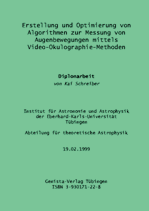Genista Wissenschaft
Erstellung und Optimierung...

Kai Schreiber
Erstellung und Optimierung von Algorithmen zur Messung von Augenbewegungen mittels Video - Okulographie - Methoden
30,- Euro
ISBN 3-930171-22-8
Diese Diplomarbeit gibt es auch in einer Online-HTML-Version.
Abstract
Measuring eye-movements is an important aid in neurological diagnostics as well as in brain research. In addition to measuring methods already in use, recent developments in the field of digital equipment have made possible video-oculography (VOG). In VOG, eye-position-data is calculated by computer-analysis of video-taped eye movement recordings. To retrieve the direction of the eye in space the center of the pupil is sought in each recorded image and the according position is calculated from a model of eye movement. The parameters of this model are to be found in a calibration sequence. For this calibration sequence I present a new algorithm along with simulated calibrations indicating its reliability. Measurement of rotations of the eye about its visual axis (i.e. measurement of 'torsion') make use of more complicated image processing algorithms. A widely used method reads a segment of the iris from a reference image and correlates this segment with the according segment from a data image to obtain the angle of torsion.
When recording moving eyes the recorded image will be blurred due to finite exposure times of the camera, thus making measurements more difficult. From simulations I obtained a maximum angular velocity up to which measurements of eye torsion are possible.
Not all patterns on the iris are equally suited for measuring torsion in the way indicated above. I developed a criterion to estimate the suitability of a given pattern regarding torsion measurement. Additionally I tried to find a method of locating the most suited iris patterns in a given image.